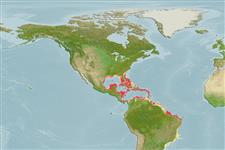Environment: milieu / climate zone / depth range / distribution range
Ecologia
marinhas associadas(os) a recifes; intervalo de profundidade 10 - 40 m (Ref. 5222). Subtropical; 33°N - 29°S, 98°W - 33°W (Ref. 5222)
Western Atlantic: southern Florida (USA) and the Gulf of Mexico to Brazil. It was suggested that Mycteroperca tigris was a transient species in the northwestern Gulf of Mexico, but has recently become abundant on the Flower Garden Banks off Texas (Ref. 6887).
Length at first maturity / Tamanho / Peso / Idade
Maturity: Lm 46.0, range 34 - ? cm
Max length : 101 cm TL macho/indeterminado; (Ref. 26340); common length : 40.0 cm TL macho/indeterminado; (Ref. 5217); peso máx. Publicado: 10.0 kg (Ref. 5222)
Espinhos dorsais (total) : 11; Raios dorsais moles (total) : 15 - 17; Espinhos anais: 3; Raios anais moles: 11. Distinguished by the following characteristics: Back crossed by about 11 pale narrow lines that slope downward and forward. No other grouper in the Caribbean has the same pattern of narrow pale diagonal lines (Ref. 26938). Further characterized by having depth of body contained 3.1-3.6 times in SL; head length 2.5-2.8 times in SL; flat interorbital area; rounded preopercle, without lobe at angle; diameter of posterior nostrils 3-5 times larger than anterior ones; large teeth, well developed canines (Ref. 89707).
A solitary species (Ref. 26340) occurring in coral reefs and rocky areas. It is considered an ambush predator that hides among the coral and sponges and is easy to approach. Frequents cleaning stations (Ref. 9710). The size versus sex distribution of Bermuda population indicates that this species is a protogynous hermaphrodite; all fish less than 37 cm TL were females and all fish larger than 45 cm TL were males (Ref. 6886). Randall (Ref. 33) reported food of 59 specimens 15 to 57 cm SL were purely fishes of a variety of species.
Life cycle and mating behavior
Maturidade | Reprodução | Desova | Ovos | Fecundidade | Larvas
Heemstra, P.C. and J.E. Randall, 1993. FAO Species Catalogue. Vol. 16. Groupers of the world (family Serranidae, subfamily Epinephelinae). An annotated and illustrated catalogue of the grouper, rockcod, hind, coral grouper and lyretail species known to date. Rome: FAO. FAO Fish. Synop. 125(16):382 p. (Ref. 5222)
Categoria na Lista Vermelha da IUCN (Ref. 130435: Version 2024-2)
Ameaça para o homem
Reports of ciguatera poisoning (Ref. 30911)
Utilização humana
Pescarias: espécies comerciais; peixe desportivo: sim; Aquário: Aquários públicos
Ferramentas
Relatórios especiais
Descarregue XML
Fontes da internet
Estimates based on models
Preferred temperature (Ref.
123201): 24.7 - 28, mean 27 °C (based on 148 cells).
Phylogenetic diversity index (Ref.
82804): PD
50 = 0.5000 [Uniqueness, from 0.5 = low to 2.0 = high].
Bayesian length-weight: a=0.01122 (0.00647 - 0.01946), b=3.06 (2.91 - 3.21), in cm total length, based on LWR estimates for this species & Genus-body shape (Ref.
93245).
Nível Trófico (Ref.
69278): 4.5 ±0.8 se; based on diet studies.
Generation time: 10.0 ( na - na) years. Estimated as median ln(3)/K based on 1
growth studies.
Resiliência (Ref.
120179): Baixo, tempo mínimo de duplicação da população 4,5 - 14 anos (K=0.11; tm=6.5-9.5).
Fishing Vulnerability (Ref.
59153): High vulnerability (64 of 100).
Nutrients (Ref.
124155): Calcium = 13.3 [7.5, 27.5] mg/100g; Iron = 0.455 [0.229, 0.802] mg/100g; Protein = 19.4 [17.6, 21.1] %; Omega3 = 0.192 [0.110, 0.338] g/100g; Selenium = 16.8 [7.6, 35.7] μg/100g; VitaminA = 71.6 [22.0, 263.4] μg/100g; Zinc = 0.511 [0.329, 0.788] mg/100g (wet weight);
